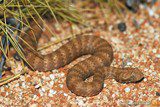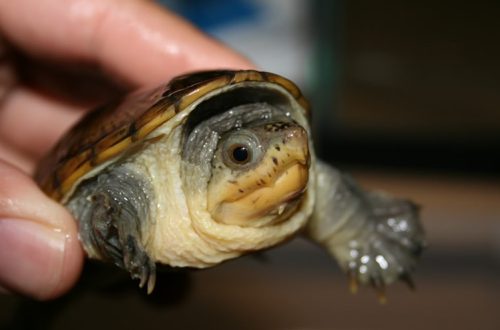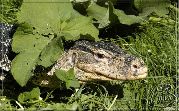
Striped monitor lizard
The striped monitor lizard (Varanus salvator) is a species of animal that belongs to the class of reptiles. It has many names, depending on where it is distributed. On the island of Bali, striped monitor lizards are called “Alyu”, and on the island of Flores – “Veti”. In other areas of Malaysia and Indonesia, these animals are called “Biawak Air” by the local population. In Thailand, they are called nothing more than “Khiah”, but more often they use the term “Tua-nguyen-tua-tong”. In Sri Lanka, striped monitors are called “Karabaragoya”, while in Bengal they are called “Ram godhika”, “Pani godhi” or “Pani goisap”. In the Philippines, these monitors are called “Halo”, but the most commonly used name is “Bayavac”.
Contents
Description
The structure of this species of reptiles includes a number of subspecies, the variation of which depends on the conditions of their habitat and periods of discovery.
The striped monitor lizard is a large animal that, in its adult state, reaches a length of 2.2 meters, and sometimes up to 3. while the weight can reach under 100 kg. The salvator has a longitudinal row of wide scutes on the upper part of the head above the eyes, as well as egg-shaped nostrils, which are located closer to the end of the muzzle. The upper part of the body of these animals is colored black or dark olive with rows of yellow dots and eyes transverse to the back. A black stripe runs in the temporal region of the skull. The lower part of the body has a solid yellow color.
Distribution
The striped monitor lizard has a very wide range of its habitat. Its large population is found in India in the Andamans and Nicobars. Salvator retained territory in Orissa, West Bengal, Assam, the vicinity of Calcutta and the Garo hills. These animals are still found in the east of the Himalayas, and in Sri Lanka they make up large populations. Also, a large number of them live in southern China (Yunnan, Kwantung, Kwangshi and Hainan), Burma, Thailand, Laos, Cambodia, Vietnam, Malaysia, Borneo, the Philippines and the Indonesian Islands in the East to about Flores, Sulawesi and Halmahera. Populations have declined strongly in the vicinity of Hong Kong and in most of the Philippines. Their disappearance is connected, first of all, with the accelerated pace of urbanization, as a brightly scorched example is the deforestation of mangrove forests.
Depending on the habitat of the subspecies of the striped monitor lizard, it has a variation in its color, which ranges from black to green. The size of the body of animals also lends itself to variability.
Salvatore lives in its greatest density in mangrove forests, but is sometimes found in the vicinity of Asian cities. A natural limitation on the distribution of these animals is their attachment to water resources. In cities, they can live in ponds, rivers, toss and turn in heaps of garbage and ruin garbage dumps.
Life in nature
The striped monitor lizard is one of the most water-loving representatives of its kind; it lives along the banks of rivers, lakes and sea coasts. These animals swim and dive superbly, using their long and laterally flattened tail, along the upper edge of which enlarged scales pass like a double keel, like an oar. Due to this, they can overcome large expanses of water, which greatly influenced their distribution range, as they inhabit remote islands. They settled the islands of the Krakatoa group after the volcanic eruption in 1883, 25 years before the arrival of other vertebrates there.
Striped monitor lizards are always observed in large numbers along river banks. By 8 o’clock in the morning they leave their shelters and bask in the sun, ready to rush into the water at the slightest danger. This may be accompanied by a great noise as the monitor splashes its belly against the surface of the water, or a soft splash as it plunges head first into it. These animals can stay under water for a considerable time without making any attempts to surface. This interval can be up to 30 minutes, but only if the monitor lizard lies at the bottom of the reservoir without moving.
The activity of monitor lizards occurs at their low body temperatures. Animals prefer microspheres of habitat that allow them to maintain a relatively constant body temperature. The variation in body temperature can be between 29.5 and 37°C in active salvators. The average length of time they spend basking in the sun is about 40 minutes. Due to the fact that individuals are already active at low temperatures, in striped monitor lizards the metabolic process is slower compared to other species of monitor lizards.
When danger arises, salvatores prefer to hide in the water, but if they have to engage in battle, then, like many other animals, they defend themselves from the enemy with the help of powerful jaws and a strong tail. He delivers powerful, accurate and strong blows with them.
On land, they do not run very fast, so it is not difficult for a person to catch up with him.
Striped monitor lizards spend most of their day directly in the water, or close to it. The activity of these animals in many regions falls on the morning period. At night, animals hide in trees, caves and dense thickets. Their caves can reach 10 meters in length.
During the day, striped monitor lizards are usually located on trees that grow along the banks of rivers and streams. In their crown, they lie in wait for small birds and lizards, and also rob nests by eating eggs.
He also settles near human habitation and even behind the fence of houses and then becomes a dangerous predator for poultry, cats and small dogs.
Striped monitor lizards feed on animals that they can only catch. Their list includes all kinds of mammals (rodents, deer, monkeys, etc.), mollusks, reptiles (frogs, turtles, lizards, crocodiles) and birds, and, in the absence of live prey, they eat carrion. Salvators can destroy bird nests, penetrate poultry farms and drag chickens from there, and also benefit humans by exterminating a large number of harmful rodents. These monitor lizards can even swallow the poisonous Aga toad without any harm to their health. Young representatives of the species feed on insects in the bulk of their diet, moving to other animals with age.
When eating large snakes, the monitor lizard grabs them first by the tail and, waving his head, shakes until the victim ceases to resist. He attacks even large cobras, at first he circles for a long time at a safe distance around her, and then, choosing the moment, he rushes forward and, grabbing the tired snake by the scruff, easily kills it.
Unpretentiousness in food also helped striped monitor lizards to settle on a large territory, which is sometimes sparsely populated by other animals.
Content at home
 Before you start a striped monitor lizard at home, you must be clearly aware of what size this animal can reach in adulthood. It needs a horizontal type terrarium for Palearctic animals. It should be conditionally allocated two zones: cool and hot. This is done so that the animal could choose the optimal temperature regime at the moment. The daytime temperature should be kept around 37°C in the heating area and around 26°C in the cool area. At night it should be 26-23°C respectively. A vital necessity for monitor lizards, as well as for other reptiles, is the presence of an ultraviolet light lamp. It also needs to place snags and a large stone both in the hot zone and in the cool one, so that the animal has the opportunity to climb and sleep on them. As a bedding, it is best to use a plastic artificial turf with a pile height of 2mm.
Before you start a striped monitor lizard at home, you must be clearly aware of what size this animal can reach in adulthood. It needs a horizontal type terrarium for Palearctic animals. It should be conditionally allocated two zones: cool and hot. This is done so that the animal could choose the optimal temperature regime at the moment. The daytime temperature should be kept around 37°C in the heating area and around 26°C in the cool area. At night it should be 26-23°C respectively. A vital necessity for monitor lizards, as well as for other reptiles, is the presence of an ultraviolet light lamp. It also needs to place snags and a large stone both in the hot zone and in the cool one, so that the animal has the opportunity to climb and sleep on them. As a bedding, it is best to use a plastic artificial turf with a pile height of 2mm.
Striped monitor lizards need to have a reservoir in their terrarium – a pool from which the animal can drink and where it has the opportunity to completely immerse itself for rest and defecation. It is advisable to take a bath of settled water at least several times a week and bathe the monitor lizard.
It is better not to keep more than one animal in one terrarium, except during the breeding season, as this will lead to constant fights. Females during the laying period become very aggressive and irritable.
Striped monitor lizards are predators and scavengers rolled into one. They are not whimsical in nutrition, but when feeding them, one should strive for diversity. The main thing is not to overfeed the animal, as they often become obese with all the ensuing consequences. Salvators need to be fed with everything that they eat in nature, namely, rodents, fish, mollusks, large insects, birds and eggs. It is important to remember that all foods that you give to a monitor lizard must be warm, otherwise the animal will have digestive problems, even death.
Physiology of reproduction
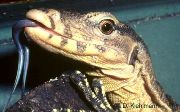 Striped monitor lizards reach their sexual maturity when their body length reaches 120 cm in the female and 130 cm in the male. Under good conditions, monitor lizards reach this length in two years from the moment of their birth. In the tropics with a large food supply, salvators are capable of breeding all year round. In regions with limited resources for food, as well as in places with seasonally changing food, the period of mating and laying eggs occurs at the beginning of the rainy season.
Striped monitor lizards reach their sexual maturity when their body length reaches 120 cm in the female and 130 cm in the male. Under good conditions, monitor lizards reach this length in two years from the moment of their birth. In the tropics with a large food supply, salvators are capable of breeding all year round. In regions with limited resources for food, as well as in places with seasonally changing food, the period of mating and laying eggs occurs at the beginning of the rainy season.
A large female can lay up to 15 eggs in a clutch at a time, and in a year there can be up to 3-4. Holes, live and abandoned termite nests, and tree hollows serve as places used for laying eggs. The duration of the incubation period varies greatly and depends on environmental conditions. At a temperature of 30°C, young individuals hatch in 180 – 327 days.
A clutch that has gone through full development may enter a dormant phase, and only if there is a sufficient amount of precipitation, a new generation of reptiles begins to hatch into the light.
Striped monitor lizards grow very quickly even with satisfactory nutrition. Juvenile Salvators are lighter in color than their parents, but otherwise do not differ significantly in color from adults.
Significance in Aboriginal culture and economy
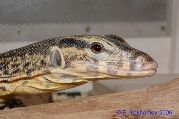 The striped monitor plays an important economic, cultural and religious role among the native tribes that inhabit its habitats.
The striped monitor plays an important economic, cultural and religious role among the native tribes that inhabit its habitats.
So the natives get it by tearing it out of holes in order to eat its meat.
Among the Hindus, salvator plays an important role in the preparation of deadly poisons, which are used by the Singhalese to this day. For the manufacture of this terrible poison, which is called the “puncher”, such snakes as the spectacled snake (Naja naja), the chain viper (Vipera russellii) and the caravila (Ancistrodon hypnale) are used, which are cut on the head and then hung over the vessel, thinking in this way way to collect their poison. The collected blood is mixed with arsenic and other poisonous drugs, and then boiled in a human skull with the help of musk deer. In this case, monitor lizards play the role of mysterious animals. Salvators are tightly tied in front of the fire from three sides, in such a way that their heads are turned to the fire, they are beaten hard and tortured, which is why they hiss and seem to fan the fire. The saliva which flows from their mouths during this torment is carefully collected and added to the aforementioned brew, which is considered ready when an oily liquid appears on its surface. The real potent agent in this brew is arsenic, but the harmless kabaragoya, due to the quackery of medicine men, enjoys a very bad reputation in these countries, and all people are still very much afraid of it.
In Ceylon, however, as elsewhere, the striped monitor lizard adheres to rivers, and. when they dry out, it is forced to move on the ground, often getting into the courtyards and dwellings of the Singhalese. Among them, this is considered a very bad sign that people are in for illness, death, and other kinds of misfortune. Therefore, they urgently go to the healers to prevent the consequences of the impending disaster. The natives, led by him, come to the yard where they saw the monitor lizard and begin to sing loudly, it consists of a few words denoting that from now on all the bad consequences of visiting the kabaragoya are destroyed.
The economic importance of this animal is very high. Every year, millions of these animals are killed for their meat and skin. In this regard, its population has been greatly reduced over the past 150 years.



